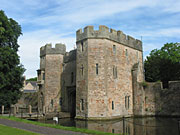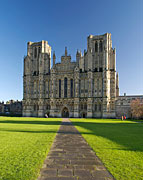 The name of the city came from the wells, which have been known since prehistoric times. These natural springs are now in the garden of the Bishop’s Palace. Stone Age flints and fragments of Roman pottery have been found near the wells and archaeological excavations also revealed the remains of an intact late Roman mausoleum, probably Christian. Unfortunately, the burial vault had been robbed of its original contents. This stone-lined chamber has postholes and slots in the walls, indicating that it was originally housed within a larger building.
The name of the city came from the wells, which have been known since prehistoric times. These natural springs are now in the garden of the Bishop’s Palace. Stone Age flints and fragments of Roman pottery have been found near the wells and archaeological excavations also revealed the remains of an intact late Roman mausoleum, probably Christian. Unfortunately, the burial vault had been robbed of its original contents. This stone-lined chamber has postholes and slots in the walls, indicating that it was originally housed within a larger building.
Recently, archaeological research has shed new light on both the springs and the mediaeval water works. The water from the springs was harnessed to drive mills, flush drains and provide a piped supply of drinking water. From the end of the 12th century, the holy well of St Andrew provided a channelled supply for the needs of the cathedral. Water still flows beneath the cloister where the remains of the mediaeval dipping place can still be seen.
What eventually became the centre of the site for today’s religious complex was also the site of a Middle Saxon mortuary chapel. The altar position could clearly be seen and there was evidence of seven burials. A mid 8th century Frisian silver coin was also discovered here, the furthest west such a coin has been found.
There was certainly a great minster church in Wells by the middle of the 8th century and most of this lies, unexcavated, under the present cloisters. It is known that an apse and underlying crypt are beneath the present east cloister. The original chapel, known as St Mary’s, was enlarged during the late Saxon period but remained separate from the minster.
 In the early 12th century, Bishop Robert partially rebuilt the church but, later that century, the foundations of an entirely new church were laid to the north of the old one, on an east-west alignment. Demolition of the Saxon cathedral began as soon as the new Gothic style church was able to be used for worship. Some of the old stone was used in the new building. St Mary’s Chapel was preserved and joined to the new east cloister at an angle. The only remaining item from the Anglo-Saxon Cathedral is the font in the south transept. The drum is over a thousand years old, but the plinth was constructed when the font was moved to the new church.
In the early 12th century, Bishop Robert partially rebuilt the church but, later that century, the foundations of an entirely new church were laid to the north of the old one, on an east-west alignment. Demolition of the Saxon cathedral began as soon as the new Gothic style church was able to be used for worship. Some of the old stone was used in the new building. St Mary’s Chapel was preserved and joined to the new east cloister at an angle. The only remaining item from the Anglo-Saxon Cathedral is the font in the south transept. The drum is over a thousand years old, but the plinth was constructed when the font was moved to the new church.
The bones of the Saxon bishops were preserved and lie in tombs with life size effigies, dating from the early 13th centuries but made to look older. Although there are only seven effigies, remains of nine bishops have been found in recent examinations.
The Wells clock still has its original mediaeval face, which depicts the universe with the earth at its centre. It was probably in place by the end of the 14th century. When the clock strikes the hour, knights exchange blows above the clock face and the Quarter Jack counts the quarter hours with his heels. The outside clock, opposite Vicars’ Hall, was placed there about seventy years later and is connected to the same mechanism.
Wells Cathedral is well worth a visit to see the intricate Gothic carvings, the clock and the chapter house, with its ancient worn staircase. The west front has 300 individual niches, many of which still contain statuary. Some of these have been damaged or lost over the years, but the remaining carvings are being restored.
 The area around the cathedral is one of the largest mediaeval ecclesiastical precincts in existence. Wells Museum is housed in a Tudor building and contains some mediaeval sculptures from the cathedral. Around the corner from the Cathedral is Vicar’s Close, the oldest complete street of 14th century houses in Europe, built to house the members of the clergy. The houses are still occupied. The nearby Old Deanery is a 12th century building.
The area around the cathedral is one of the largest mediaeval ecclesiastical precincts in existence. Wells Museum is housed in a Tudor building and contains some mediaeval sculptures from the cathedral. Around the corner from the Cathedral is Vicar’s Close, the oldest complete street of 14th century houses in Europe, built to house the members of the clergy. The houses are still occupied. The nearby Old Deanery is a 12th century building.
The Bishop’s Palace dates from the early 13th century when Jocelin Trotman, the first Bishop of Bath and Wells, received licence from the Crown to build a residence and deer park on land to the south of the Cathedral. His vaulted entrance hall can still be seen today as can the impressive banqueting hall and long gallery.
In the 14th century there was a dispute between the bishop and the city. Consequently, the palace was fortified and a moat, with a drawbridge, was constructed. The white swans, which swim in the moat today, are trained to ring a bell for food. The palace is still the official residence of the Bishop.
There are many other fascinating old buildings, including the 15th century parish church and a tithe barn. Somerset cheese is made locally and the town has its own cheese shop. There is a Tourist Information Centre in the old town. Around the old centre is the more recent part of Wells, with shops and various other modern facilities for the tourist.
This jewel of a city lies at the foot of the Mendip Hills, where there are lots of lovely walks. Wookey Hole caves are not far away, and the Ebbor Gorge Nature Reserve is within a few miles of Wells. There is plenty of holiday accommodation in the area.



